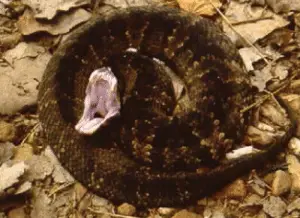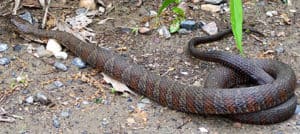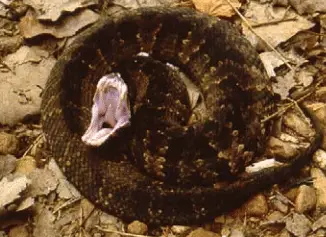
Growing up in the time before the Internet was widespread, well before Google was a thing, information wasn’t quite as reliable as it is now which is why every kid running by the river somehow saw a water moccasin every summer. Because of course, every brown or black snake had to be a cottonmouth, right? But considering I lived in a state that didn’t have cottonmouths (Iowa) that was quite a feat!
Obviously learning how do identify a water moccasin (aka cottonmouth) is a bit more complicated than that. Look for a brown or black snake with a super thick body, narrow neck, stunningly white mouth, and triangular head that indicates venom glands. They tend to have bands around the body that darken over time and the unique swimming trait of keeping their heads fully out of water while swimming.
These are the main details that can help you quickly identify a likely water moccasin as compared to a harmless water snake or other lookalike. There are some other traits that can help you to correctly tell if a snake is a cottonmouth but the next best thing you can do after knowing the main traits mentioned above is to learn how to identify common lookalikes such as water snakes.
Read on to learn more!
Unique Cottonmouth Traits
While it’s not hard to see how a big non-venomous water snake with a thick body can be mistaken for the venomous water moccasin, it is important to know the main features that can help you spot a potential cottonmouth from a distance. The further away you are when you make an identification, the better.
The most common traits are some listed above, but there are some further details that can help make a proper ID. The short list of traits:
- Especially thick body with a narrow neck and very thin tapered tail
- Normally ringed – brown with black rings, which turns to solid black by the tail in older snakes
- Younger snakes will have a yellow tipped tail they may wriggle to entice potential prey
- Bright white mouth – that is a dead giveaway very unique to the appropriately named cottonmouth
- Big blocky triangular heads
- Hourglass pattern on the back
- Tend to swim with the entire head out of the water*
*This is a clear sign that the snake could be a cottonmouth however it is important to note that sometimes these snakes will swim with their heads under the water, usually when hunting for food.
Slightly Different Color Entities
If you live in an area where these snakes naturally live, then it is important to know what the local color variations are. The reason for this is that the various color patterns of these snakes can actually vary a lot depending on several factors. The age of the snake matters as young ones have yellow tails while older ones will have completely black tails. The pink and white colored mouth is always going to be the same regardless of age.
Regionally and based on sub-species these can be brown and deep yellow with black stripes, mostly dark brown with black stripes, or virtually entirely black. This means two different cottonmouths can look different enough to even appear as separate snakes. In many places there is only one sub-species natural to the area, which will allow you to get a more direct idea of what to look for.
These venomous snakes love slow moving water. This is why they are generally more likely to be found in ponds, creeks, or small lakes as opposed to rivers or rapidly moving rapids. Add in some weeds or thick shrubbery and you have the perfect home for these types of snakes.
Other Defining Water Moccasin Features
These are distinctly filed under the “Should never EVER get this close to use these identifying markers.” While technically there are more details that can be used to compare a venomous cottonmouth vs a non-venomous water snake, these are more on the technical side versus any practical use.
These other defining features include:
- Visible heat-sensing pits underneath the eyes
- Cat-like eyes (vertical eye pupils)
- Single row of scales after the anal gland
These are all features I don’t want to see up close and personal…especially #3. However if you find yourself accidentally really up close and personal with a snake that might be a cottonmouth then look for the cat-like eye with a vertical eye lit or the clear pits underneath the eyes. I…just don’t have anything to say if somehow you can only identify it with bullet point #3 in this list.
However if you keep all these cottonmouth markings given in the article so far, you’ll quickly become a pro and telling the real thing from a pretender.

How to Tell a Cottonmouth from a Water Snake
So knowing the list of features is one thing, but using that information to learn how to tell a water moccasin from a water snake takes a little bit more work. The good news is that the same features that make this venomous snake stick out aren’t features that water snakes share.
This makes the comparison a bit easier and while it can still be tricky while at a distance or especially with particularly big water snakes that have thicker bodies, understanding these differences in-depth really does make all the difference.
This is also a good time to point out that almost all water moccasin lookalikes will be some sub-species of water snake. Northern water snakes and brown water snakes in particular are the harmless snakes that are most often mistaken for the dangerous species they are trying to mimic.
In fact the only common cottonmouth lookalikes are big water snakes. This makes sense because water snakes are found everywhere and tend to thrive in the same environments as water moccasins. Add in a relatively similar appearance to the untrained eye, especially with the larger ones, and it is easy to see how this mistake can be made.
The snake is most likely a water snake instead of a moccasin if:
- They have a small tapered head instead of large triangular one
- Long even body as opposed to ultra thick
- The neck is the same size as the head instead of much smaller
- Lack of pits and normal snake eyes (not cat-like)
- No yellow or black tail
- The snake’s neck gets much bigger as it flattens out
- The body is slender versus thick
When in doubt, just give the snake plenty of space. Even non-venomous snakes will attack when nervous, threatened, or agitated. Either way if you can simply avoid dealing with the snake that’s for the best but now with this information on how to ID cottonmouths and water moccasin mimics, you will be well prepared to spot them out in the wild.
We’ve also included three solid online resources if you want to learn more!
Other Quality Resources:

